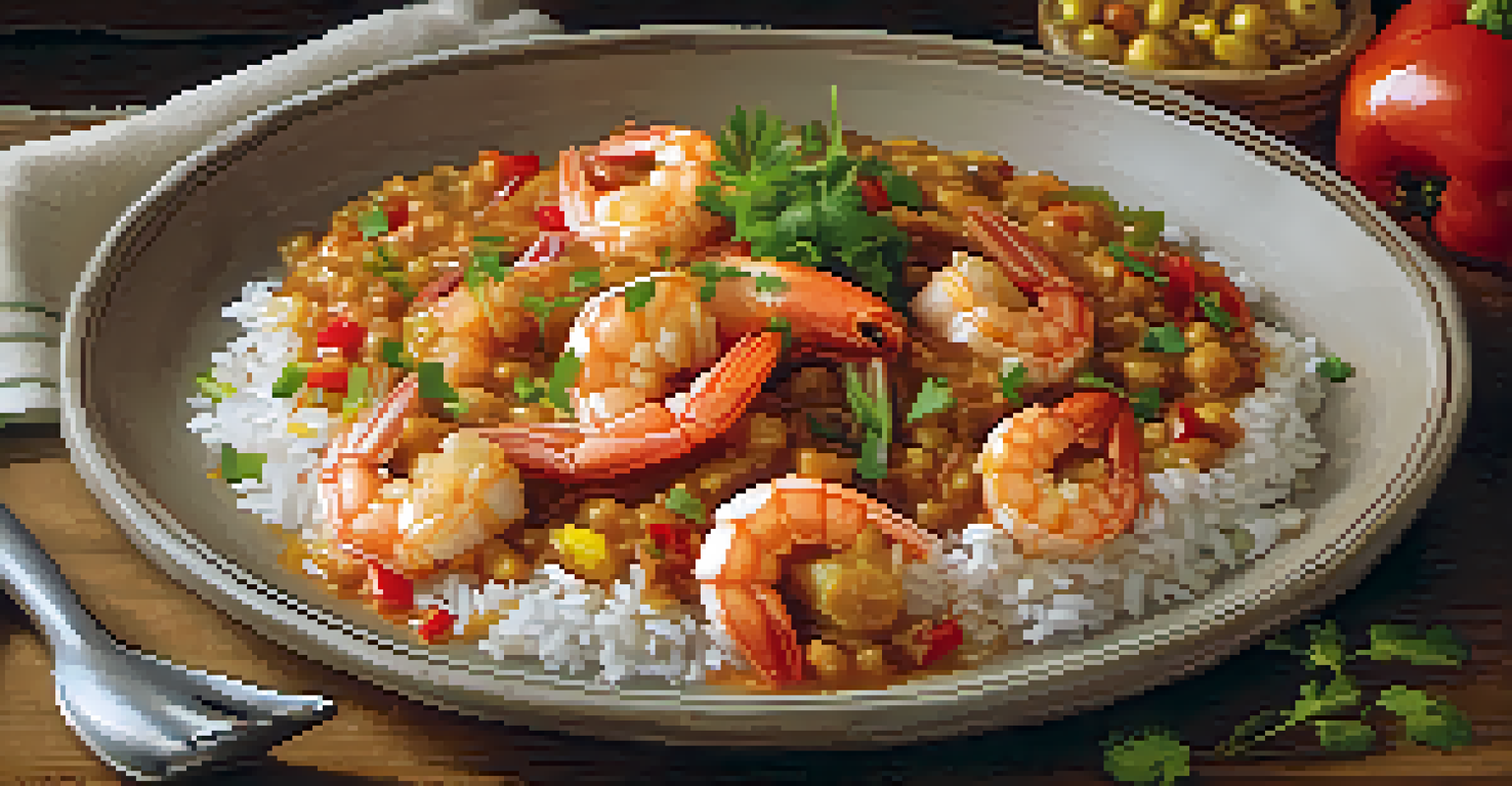The Influence of French Cuisine on Louisiana Dishes

The Roots of Louisiana Cuisine: A French Legacy
Louisiana's culinary landscape is a rich tapestry woven with French influences. The arrival of French settlers in the 18th century brought not only a new language but also a diverse range of cooking techniques and ingredients. This melding of cultures laid the groundwork for what we now recognize as Cajun and Creole cuisines, each with its unique flair.
Food is our common ground, a universal experience.
For example, the use of roux—a mixture of flour and fat—originates from French cooking and is a cornerstone in many Louisiana dishes. This technique adds depth and richness to gumbo, a beloved local staple. The French also introduced the concept of layering flavors, which is essential in creating the complex profiles found in many Louisiana recipes.
As French chefs adapted their cooking to local ingredients and tastes, they created a distinctive culinary style that still thrives today. This blending of techniques and traditions has made Louisiana a gastronomic destination, where every bite tells a story of its rich heritage.
Chefs and the Art of Adaptation: A Cultural Exchange
Adaptation plays a crucial role in the evolution of Louisiana dishes, as chefs integrate French cooking methods with local ingredients. For instance, the classic French dish 'coq au vin' has inspired the Cajun version known as 'coq au vin rouge,' which uses local spices and chicken. This innovative approach showcases the creativity and resourcefulness of Louisiana cooks.

Moreover, the influence of French cuisine is evident in the use of fresh herbs, such as thyme and parsley, which are staples in both French and Louisiana kitchens. The emphasis on fresh, local produce highlights a shared philosophy of valuing quality ingredients. This commitment to freshness is what makes Louisiana cuisine so vibrant and appealing.
French Roots Shape Louisiana Cuisine
French settlers introduced diverse cooking techniques and ingredients that laid the foundation for Cajun and Creole cuisines.
French culinary techniques, such as poaching and braising, have also found a home in Louisiana kitchens, resulting in hearty dishes like jambalaya and étouffée. These dishes exemplify how traditional French methods can be reimagined, creating something uniquely Louisiana while honoring its French roots.
Spices and Seasonings: A Flavorful Fusion
One of the most notable aspects of Louisiana cuisine is its bold use of spices, a characteristic that sets it apart from traditional French cooking. While French cuisine often relies on herbs and subtle flavors, Louisiana dishes embrace a more vibrant palette, thanks to influences from African, Spanish, and Native American cuisines.
The only thing I like better than talking about food is eating.
The famous 'holy trinity' of Cajun cooking—onions, bell peppers, and celery—can be seen as a perfect example of this fusion. While the French may use mirepoix (onions, carrots, and celery) in their dishes, the Louisiana version reflects the local agricultural bounty and tastes. This adaptation adds a distinct character to the region's dishes while still paying homage to French origins.
Additionally, the use of hot sauces and spices like cayenne pepper adds a kick that elevates Louisiana dishes to new heights. This bold approach to seasoning showcases the region's diverse culinary heritage, where French techniques meet a medley of global influences.
The Role of Festivals in Celebrating Culinary Heritage
Festivals are a vibrant part of Louisiana's culture, and they play a significant role in celebrating the region's culinary heritage. Events like Mardi Gras and the New Orleans Jazz & Heritage Festival not only showcase music and art but also highlight the incredible food that defines Louisiana. These festivals are a testament to the community's pride in its French culinary roots.
During these gatherings, local chefs often showcase traditional dishes with a modern twist, blending French techniques with regional flavors. For instance, you might find a gourmet version of crawfish étouffée that incorporates innovative ingredients while honoring its French-inspired origins. This fusion reflects a deep respect for tradition while embracing creativity.
Festivals Celebrate Culinary Heritage
Culinary festivals in Louisiana, like Mardi Gras, showcase traditional dishes that reflect the region's rich French influences and foster community.
Festivals also foster a sense of community, as people come together to share meals and stories. This communal aspect strengthens the ties between generations, ensuring that the culinary traditions rooted in French cuisine continue to thrive in Louisiana.
Iconic Dishes: A Taste of French Influence
When discussing the influence of French cuisine on Louisiana cooking, certain iconic dishes spring to mind. Gumbo, for instance, is a perfect example of this culinary blend, combining French techniques with local ingredients like okra and shellfish. The dish reflects the area's diverse cultural influences while showcasing the deep, complex flavors that characterize both French and Louisiana cuisines.
Another dish to highlight is beignets, which are reminiscent of French pastries but have been adapted to fit Louisiana's unique culinary landscape. These fluffy, powdered sugar-dusted treats are a beloved breakfast item in New Orleans, illustrating how French desserts have been embraced and transformed by local tastes.
Lastly, the famous muffuletta sandwich combines Italian influences with French bread, proving that Louisiana cuisine is a melting pot of cultures. This dish exemplifies how various culinary traditions can intersect, creating something truly unique and delicious that reflects the state's rich history.
The Importance of Local Ingredients: A Culinary Connection
At the heart of Louisiana cuisine is a commitment to using local ingredients, a principle that resonates with French cooking traditions. The emphasis on fresh produce, seafood, and meats showcases the region's agricultural wealth and its connection to the land. This philosophy ensures that dishes are not only flavorful but also reflective of the local environment.
For example, Louisiana's renowned seafood, such as shrimp, crab, and fish, is often featured in traditional dishes like shrimp étouffée and crab cakes. These ingredients not only highlight the state's coastal bounty but also align with the French tradition of using fresh, seasonal produce to enhance flavors. The result is a harmonious blend of taste and locality.
Local Ingredients Enhance Flavor
A commitment to using fresh, local ingredients is central to Louisiana cuisine, aligning with French traditions and highlighting the region's agricultural bounty.
Additionally, local farmers and markets play a crucial role in maintaining this connection to the land. Chefs often source ingredients directly from these suppliers, ensuring that their dishes are rooted in the local culinary landscape. This practice not only supports the local economy but also fosters a sense of community and sustainability within the cuisine.
The Future of Louisiana Cuisine: Preserving Tradition and Innovation
As Louisiana cuisine continues to evolve, there is a growing focus on preserving traditional French influences while embracing innovation. Modern chefs are exploring new techniques and flavor pairings, pushing the boundaries of what Louisiana food can be. This blend of tradition and creativity ensures that the culinary landscape remains dynamic and exciting.
For instance, some chefs are incorporating global flavors into classic Louisiana dishes, resulting in unique creations that still pay homage to their French roots. By experimenting with ingredients and techniques, these chefs are keeping the spirit of Louisiana cuisine alive while introducing it to a new generation of food lovers.

Moreover, there is an increasing emphasis on sustainability and ethical sourcing in the culinary community. Many chefs are committed to supporting local farmers and using seasonal ingredients, ensuring that Louisiana cuisine remains not only delicious but also environmentally responsible. This forward-thinking approach honors the past while paving the way for a vibrant culinary future.